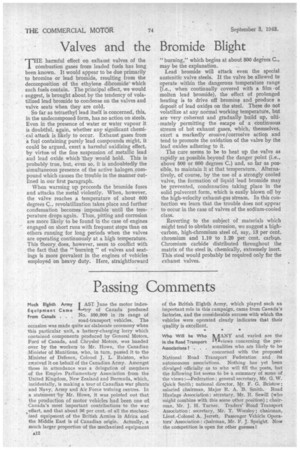Valves and the Bromide Blight
Page 14

If you've noticed an error in this article please click here to report it so we can fix it.
THE harmful effect on exhaust valves of the combustion gases from leaded fuels has long been known. It would appear to be due primarily to bromine or lead bromide, resulting from the decomposition of the ethylene dibromide which such fuels contain. The principal effect, we would suggest, is brought about by the tendency of volatilized lead bromide to condense on the valves and valve seats when they are cold.
So far as tetraethyl lead itself is concerned, this, in the undecomposed form, has no action on steels. Even in the presence of water or water vapour it is doubtful, again, whether any significant chemical attack is likely to occur. Exhaust gases from a fuel containing purely lead compounds might, it could be argued, exert a harmful oxidizing effect, by virtue of the fine suspension of metallic lead and lead oxide which they would hold. This is probably true, but, even so, it is undoubtedly the simultaneous presence of the active halogen compound which causes the trouble in the manner outlined in our first paragraph.
When warming up proceeds the bromide fuses and attacks the metal violently. When, however, the valve reaches a temperature of about 600 degrees C., revolatilization takes place and further condensation becomes impossible until the temperature drops again. Thus, pitting and corrosion are more likely to be found in the case of engines engaged on short runs with frequent stops than on others running for long periods when the valves are operating continuously at a high temperature. This theory does, however, seem to conflict with the fact that the "burning " of valves and seatings is more prevalent in the engines of vehicles employed on heavy duty. Here, straightforward "burning," which begins at about 800 degrees C., may be the explanation.
Lead bromide will attack even the special austenitic valve steels. If the valve be. allowed to operate within the dangerous temperature range when continually covered with a film of molten lead bromide), the effect of prolonged heating is to drive off bromine and produce a deposit of lead oxides on the steel. These do not volatilize at any normal working temperature, but are-very, coherent and gradually build up, ultimately permitting the escape of a continuous stream of hot exhaust gases, which, themselves, exert a markedly erosive /corrosive action and tend to promote the oxidation of the valve by the lead oxides adhering to it. • The cure seems to be to heat up the valve as rapidly as possible. beyond the danger point (i.e., above 500 or 600 degrees C,.) and, so far as possible, to maintain it at that temperature. Alternatively, of course, by the use of a strongly cooled valve, the formation of liquid lead bromide may be prevented, condensation taking place in the solid pulverent form, which is easily blown off by the high-velocity -exhaust-gas stream. In this conhection we learn that the trouble does not appear to occur in the case of valves of the sodium-cooled class.
Reverting to the subject of materials which might tend to obviate corrosion, we suggest a highcarbon, high-chromium steel of, say, 13 per cent. chromium and 1.10 to 1.20 per cent. carbon. Chromium carbide distributed throughout the • matrix .of the steel is, chemically, extremely inert. This steel would probably be required only for the exhaust valves.




















































